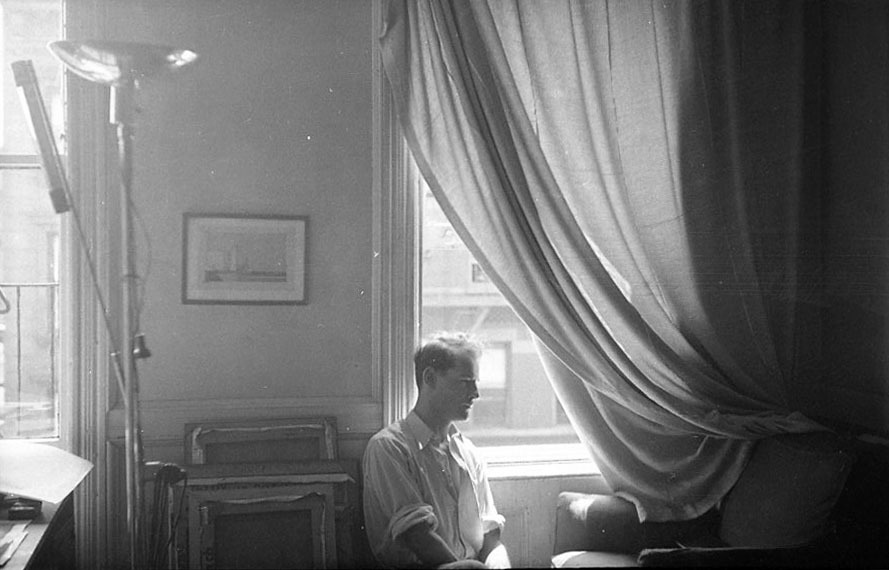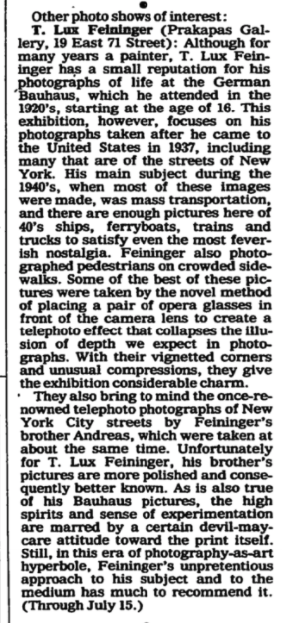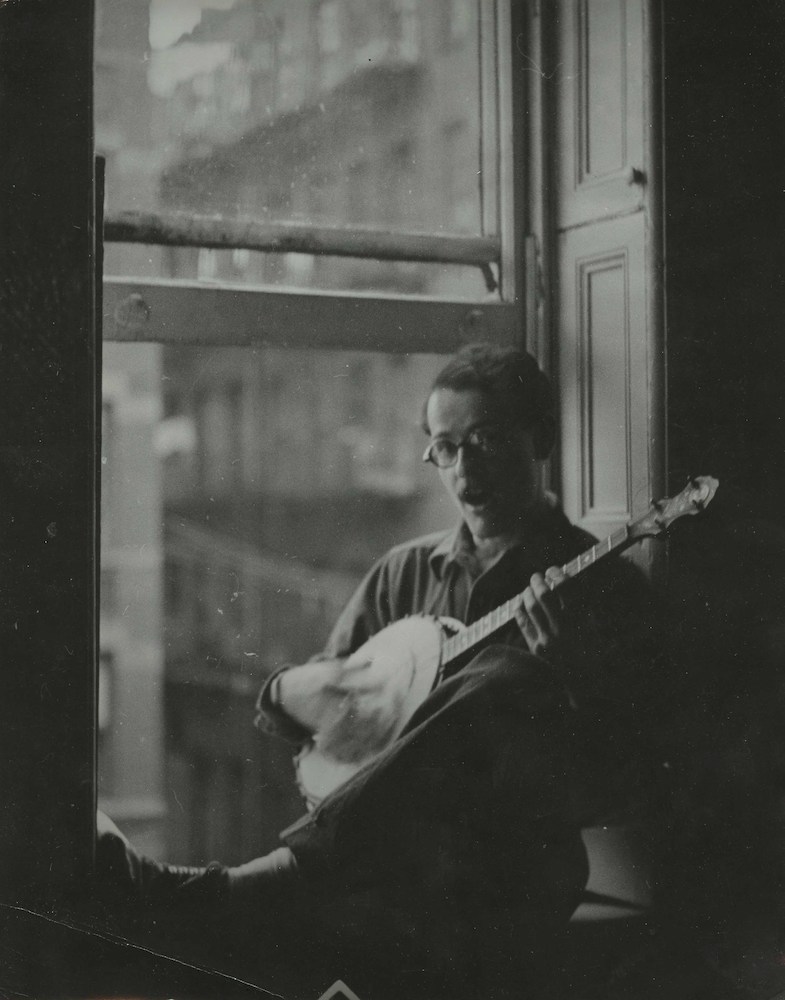Archive
T. Lux Feininger
- T. Lux
- Feininger
Theodore Lukas
- 10-06-1910
- Berlin (DE)
- 14-07-2011
- Cambridge (US)
- PhotographerPainter
Lux T. Feininger was a German-American émigré photographer and painter and the brother of the photographer Andreas Feininger, arriving in 1936 in New York. Although he started taking photographs during the 1920s in Germany, Feininger is better known for his career as a painter and his photographic work is largely unacknowledged.
Word Count: 50

T. Lux Feininger, Selfportrait in 511 East 85 Street, 1937, New York (© The Estate of T. Lux Feininger, Repro: www.Kunst-Archive.net). 
Announcement of an exhibition at the MINT Museum of Art showing works by Lyonel, Andreas as well as T. Lux Feininger. The Charlotte News, 24 December 1955, p. 17 (Photo: Helene Roth). 
Announcement of an exhibition of T. Lux Feininger’s photographs at the Prakapas Gallery. The New York Times, 17 June 1983, p. c12 (Photo: Helene Roth). 
Article on the 1930s Bauhaus Photography exhibition, where also works by T. Lux Feininger were shown. The Boston Globe, 14 June 1984, p. 52 (Photo: Helene Roth). Anonymous. “Emory University Museum Of Art And Archeology.” The Atlanta Constitution, 13 July 1985, p. 125.
Anonymous. “Imagery that gives off Bauhaus vibrations.” The Boston Globe, 14 June 1984, p. 52.
Anonymous. “T. Lux Feininger.” The New York Times, 17 June 1983, p. c12.
Anonymous. “Mint To Show Works of Remarkable Family.“ The Charlotte News, 24 December, 1955, p. 17.
Feininger – Vater und Söhne, exh. cat. Städtische Galerie Karlsruhe, Karlsruhe, 2001.
Feininger, Andreas, and T. Lux Feininger. Lyonel Feininger. Die Stadt am Ende der Welt. Rütten & Loening, 1965.
Feininger, Theodore Lux. “Ein Fenster auf den East River – Das Teleskop-Fotoexperiment von 1946.“ (1983). Kunst-Archive.net. Accessed 27 April 2021.
Feininger, Theodore Lux. Zwei Welten: Mein Künstlerleben zwischen Bauhaus und Amerika. Translated by Florian Bergmeier, Mitteldeutscher Verlag, 2006.
Grimes, William. “T. Lux Feininger, Photographer and Painter, Dies at 101.” [url=/ www.nytimes.com/2011/07/14/arts/t-lux-feininger-photographer-and-painter-dies-at-101.html]The New York Times[/url], 13 July 2011. Accessed 7 April 2021.
Smith, C. Zoe. “Émigré photography in America: contributions of German photojournalism from Black Star Picture Agency to Life magazine, 1933–1938.” (unpublished dissertation, School of Journalism in the Graduate College of the University of Iowa, Iowa City, December 1983).
Smith, C. Zoe. “Black Star Picture Agency: Life’s European Connection.” Journalism History, vol. 13, no. 1, 1986, pp. 19–25.
Smith, C. Zoe. “Die Bildagentur ‘Black Star’. Inspiration für eine neue Magazinfotografie in den USA.” Kommunikation visuell. Das Bild als Forschungsgegenstand – Grundlagen und Perspektiven, edited by Thomas Knieper and Marion G. Müller, Herbert von Halem, 2001, pp. 240–249.
Welten-Segler. T. Lux Feininger zum 100. Geburtstag. Werke 1929–1942, edited by Ulrich Luckhardt and Peter Thurmann, exh. cat. Kunsthalle zu Kiel, Kiel, 2010.
Word Count: 248
My deepest thanks go to Conrad Feininger, the son of Lux Feininger, as well as to Cecilia Witteveen and Siegfried Schäfer (www.Kunst-Archive.net) for providing me with information and images by T. Lux Feininger.
Word Count: 36
Paris, France (1932–1935); New York City, US (1936-1953); Cambridge, Massachusetts, US (1953–2011).
511 East 85th Street, Yorkville, New York City (residence and workplace, 1937–1939); 118 Perry Street, Greenwich Village, New York City (residence and workplace, 1939–1940); 129 Perry Street, Greenwich Village, New York City (residence and workplace,1940–08.1941); 235 East 22nd Street, Kips Bay, New York City, (residence of Julia and Lyonel Feininger, 08.1941–09.1941); 225 West 10th Street (09.1941–04.1942); 105 East 24th Street, Flatiron District, New York City (residence and workplace, 1946–1953).
- New York
- Helene Roth. "T. Lux Feininger." METROMOD Archive, 2021, https://archive.metromod.net/viewer.p/69/2948/object/5138-11025178, last modified: 28-09-2021.
-
Andreas FeiningerPhotographerWriterEditorNew York
Andreas Feininger, was a German émigré photographer who arrived in New York with his wife Wysse Feininger in 1939. He started a lifelong career exploring the city's streets, working as a photojournalist and writing a large number of photography manuals.
Word Count: 39
Lisette ModelPhotographerNew YorkLisette Model was an Austrian-born photographer who lived in New York with her husband Evsa Model after emigrating from France. Her street photographs capturing the curiosities of everyday life quickly caught the interest of museums and magazines.
Word Count: 37
Ernest NashPhotographerArchaeologistLawyerNew YorkErnest Nash was a German born photographer, who pursued his photographic as well as an archeologic interest in Roman architecture after his emigration to New York in 1939. Besides this research interest, he also worked as a portrait photographer and publisher.
Word Count: 40
Ellen AuerbachPhotographerNew YorkWhen she arrived in New York in 1937, the German-born photographer Ellen Auerbach (formerly Rosenberg) had already passed through exile stations in Palestine and Great Britain.
Word Count: 25
Carola GregorPhotographerSculptorNew YorkThe German émigré photographer Carola Gregor was an animal and child photographer and published some of her work in magazines and books. Today her work and life are almost forgotten.
Word Count: 30
Rudy BurckhardtPhotographerFilmmakerPainterNew YorkRudy Burckhardt was a Swiss-born photographer, filmmaker and painter who emigrated from Basle to New York City in 1935. He was well networked within the emerging Abstract Expressionist art scene of 1940s' and 50s'.
Word Count: 33
László Moholy-NagyPhotographerGraphic DesignerPainterSculptorLondonLászló Moholy-Nagy emigrated to London in 1935, where he worked in close contact with the local avantgarde and was commissioned for window display decoration, photo books, advertising and film work.
Word Count: 30
Fred SteinPhotographerLawyerNew YorkAlways accompanied by his camera, the German émigré photographer Fred Stein discovered New York City during the 1940s and 1950s. His pictures provide an human and multifaceted view of the metropolis.
Word Count: 31
Lotte JacobiPhotographerNew YorkIn October 1935 the German émigré photographer Lotte Jacobi, together with her sister Ruth Jacobi, opened a photo studio on 57th Street. The two sisters had to leave their parents' photo studio in Berlin in the 1930s and emigrated to New York.
Word Count: 41
Lilo HessPhotographerNew YorkThe German émigré Lilo Hess was an animal photographer working for the Museum for Natural History and the Bronx Zoo, as well being a freelance photographer and publisher of children's books.
Word Count: 31
Lilly JossPhotographerNew YorkLilly Joss was an émigré freelance photographer in New York. She worked for the Black Star photo agency and magazines and was also a portrait and theatre photographer.
Word Count: 28
YllaPhotographerNew YorkYlla was an Austrian-born photographer who emigrated to New York in 1941. Specialising in animal photography, she produced not only studio photographs, but also shot outside on urban locations in the metropolis.
Word Count: 31
Fritz HenlePhotographerNew YorkFritz Henle was a German Jewish photographer who emigrated in 1936 to New York, where he worked as a photojournalist for various magazines. He also published several photobooks of his travels throughout North America and Asia.
Word Count: 35
Trude FleischmannPhotographerNew YorkTrude Fleischmann was an Austrian-Jewish portrait and dance photographer who emigrated in 1939 to New York, where she opened a studio in Midtown Manhattan with the photographer Frank Elmer.
Word Count: 28
Julien Levy GalleryArt GalleryNew YorkThe Julien Levy Gallery was founded by the art dealer Julien Levy (1906–1981) in 1931, and was situated in the New York gallery district around 57th Street, where the Weyhe and Norlyst Gallery were also located.
Word Count: 34
